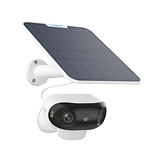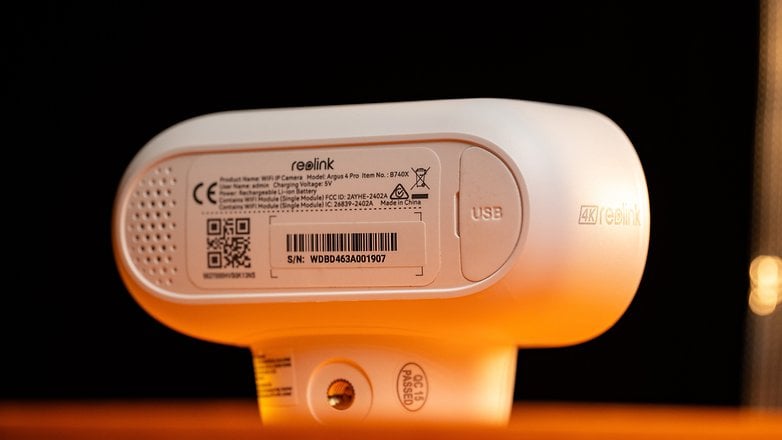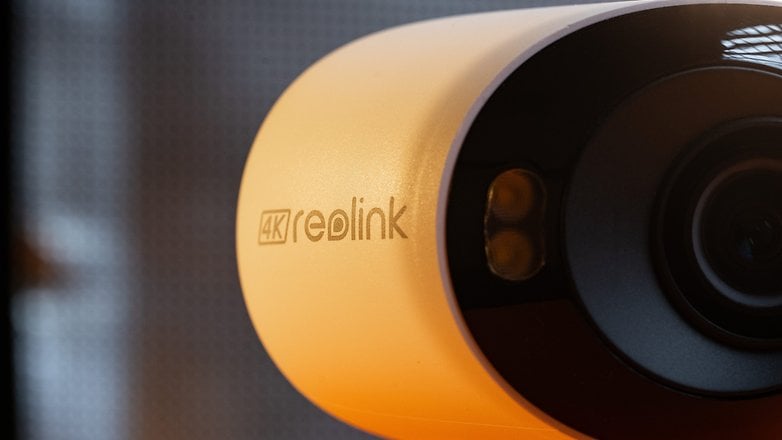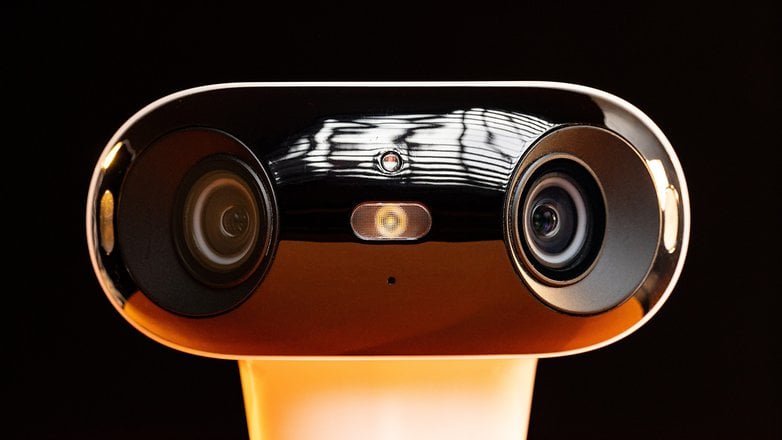With a 180° wide field of view, a powerful solar panel on the side, and night vision with color display, the Argus 4 Pro from Reolink does pack some special features. However, with an asking price of $219.99 a pop, it can be rather expensive. Is it still worth buying? Let’s take a closer look in the nextpit review!
Good
- Large field of vision with 180° coverage
- Solar panel effectively extends battery life
- Compatible with Alexa and Google Home
Bad
- microSD card is not secured in the camera
- Connection to network storage is only available via additional devices
- Too tiny

Reolink Argus 4 Pro: All deals
In a nutshell
The Argus 4 Pro offers great hardware with top image quality. Unfortunately, it can only be integrated into your smart home to a very limited extent. The optional Solar Panel 2 accessory does prove to be a useful addition but above all, the battery life falls below average. Overall, we give it 3.5 out of 5 stars!
Design & build quality
Set up, scan the QR code, set up – setting up the Reolink Argus 4 Pro could hardly be easier. The design is a mixture of cool and discreet. Reolink also includes some practical accessories for attaching the camera and the solar panel. There is also protection against water and dust. Unfortunately, there is no theft protection for the required microSD cards.
Pros:
- Attractive design, both for the camera and the solar panel.
- Two cameras, motion sensors, and lights are integrated within a compact chassis.
- Lots of accessories for mounting without the need to drill!
Cons:
- microSD cards are hidden only by a rubber cap.
- You only get one color — white.
If you have already set up a smart home device, you should be able to get the Argus 4 Pro up and running in no time at all. However, I recommend you set it up before attaching the camera and solar panel, as you will need to scan a QR code that is located at the back of the camera. After downloading the Reolink app, you can proceed with the setup. The good news? There is no need to create an account!

To perform a fixed installation of the surveillance camera, Reolink included two different wall mounts in the box. One of them allows a more precise setup thanks to the ball head, while the other allows the camera to be mounted at a slightly longer distance from the wall. I also think it’s clever how Reolink offers screws and tension straps for each mount, which can be used to attach the camera to posts or wooden beams without requiring any drilling.
Due to the high field of view (more on this later), the camera is particularly suitable for outdoor use. Both the camera and the solar panel are protected against water splashes. The IP66 certification offers protection against high-pressure water jets. This means the camera should be able to withstand the buffeting of heavy rain. Another nice touch? Thanks to rubber seals, there are no weak points that could allow water to penetrate even when the USB-C cable of the solar panel is plugged in.

The same applies to the microSD card slot that can hold up to 128 GB of storage space and is located on the underside of the camera. Together with a power button, they are well hidden by a rubber flap. Unfortunately, you cannot screw it down or protect it in any other way. Theoretically, it would therefore be possible for a burglar to remove the memory cards if you don’t use the Reolink Cloud, making the potentially security-relevant recordings disappear.
App & smart functions
To set up the Argus 4 Pro, you will first need the Reolink app which is available free of charge on Android and iOS. As a smart surveillance camera, you can control it via Google Home. However, there is no Matter support or native compatibility with Apple HomeKit and Amazon’s Alexa. In general, Reolink does seem to hold back when it comes to smart home functions.
Pros:
- Clear and easy-to-understand app.
- Can also be used without an account and a cloud connection.
Cons:
- Reolink’s cloud is available for a fee and remains exclusive.
- No network storage function.
- Natively compatible with Google Home only.
What I like about Reolink is how you can access many camera functions without requiring an account. To do this, you first set up the camera via the app and use the Reolink app to view the camera image. You can also rely on notifications whenever people or movements are detected. As the camera saves video clips of events to a microSD card, you can implement a security function without an account or cloud.

You can also access the camera remotely outside of your Wi-Fi network. According to the manufacturer, Reolink uses AES encryption when accessing the camera via the Reolink app and follows the TLS standards. Alternatively, you can also access the Reolink camera via a desktop application using either a special ID or the camera’s IP address. In each case, Reolink asks for the camera’s password. You only need to worry about unauthorized access if you share the camera with a static IP address via your router.
As for the Reolink app, you have two more functions that belong in this category. The first is access to Reolink’s cloud storage, which allows you to store recordings on the manufacturer’s AWS (Amazon Web Services) servers. Hence, if a crook steals your camera or microSD card, the data remains. Using it for free is not possible, nor is switching to another cloud provider for which you are already paying money. If you want to store data locally on a NAS instead, this is only possible by purchasing the “Reolink Home Hub”. This requires you to budget You will have to budget an additional $100.

Reolink’s smart home connection options are just as limited as the network storage options. Only connection to Google Home is available natively. You can only display the camera image on connected smart displays via voice. There is a Reolink skill for Amazon Alexa, which you can also use to access the camera. However, this integration is not really that “sexy”. In the smart home category, the Argus 4 Pro doesn’t score very highly.
Picture quality & audio
The Argus 4 Pro generates a 4K image from two cameras, which is streamed and saved at 15 frames per second. Two-way audio provides communication options for thieves and the mailman, and a special night mode is also intended to provide color at night. In terms of image quality, Reolink wants to be one of the best on the market, but does that even make any sense?
Pros:
- Large field of view with razor-sharp 4K image.
- Good audio quality when listening and talking.
- Many options to adjust the picture and to “censor” certain areas.
Cons:
- Large field of view is difficult to show on displays.
- Rather large blind spot below the camera.
While the Argus 4 Pro scored less in terms of smart home functions, it stood out in terms of image quality. After all, delivering 4K resolution with a 180° field of view certainly offers advantages for certain applications. For install, if you only want to install a single camera for your garden and want to clearly recognize license plates or faces thanks to the higher resolution.

Instead of using a fisheye lens, which would also provide a similar field of view, Reolink relies on two cameras and combines their image sections in the camera. This results in an aspect ratio of 32:9, which is reminiscent of a panoramic image. In reality, the advantage lies in you seeing less of the ground and sky. However, this creates a blind spot below the camera. If we remember that you can remove the camera’s microSD card without any tools, this is a rather serious oversight.

However, the image quality is really good overall. Using the app, you can freely zoom into the streamed image and thus recognize people or license plates. With the Argus 4 Pro, Reolink also advertised its ColorX technology, which supposedly provides a colorful image even in the dark and without having to activate the integrated LED headlights. This is touted to be possible thanks to the fast lenses with an f/1 aperture and the large sensor. In reality, however, the camera regularly turns on the built-in lights when dark. In gardens where lamps are lit in the evening, however, this can certainly be an advantage.
The Argus 4 Pro relies on a motion detector with PIR technology to control the integrated LEDs and begin recording. Whenever it detects movement, you can choose to receive a notification on your smartphone. A short while after that, the camera then reports whether it is a person, a vehicle, or an animal. All movements are recorded and stored on the microSD or optionally in the cloud. To protect your privacy or that of your neighbors, certain zones in the image can be censored.

By default, these recordings also contain an audio track that is pleasantly clear and understandable. Recorded conversations remained intelligible in the test recordings and the 2-way audio also impressed us in the review.
Last but not least, the camera stood out with its many setting options. For instance, you can control the sensitivity of the motion detector, adjust the highlights and shadows of the camera image, adjust the merging of the two camera images, and much more. Bravo, Reolink!
Battery and charging
Ideally, you should never have to charge the 5,000 mAh battery in the Argus 4 Pro. This is because the more expensive bundle (just $20 more) includes a solar panel that can recharge the camera without the need for a power socket. Thanks to ColorX technology, Reolink can dispense with infrared lamps for night vision, so the camera should offer a longer battery life.
Pros:
- The solar panel performed well during the review duration.
Cons:
- Battery life seems to be rather below average.
- Having a permanent power supply can be difficult.
- Must be disassembled for charging.
For our review, Reolink sent us the Argus 4 Pro together with the Solar Panel 2 accessory, which according to the technical specifications, offers a maximum output of 6 W. As it is a little difficult to review the camera outside in my Berlin apartment, I decided to do so indoors and placed the solar panel on a camera tripod in front of the window. I opened this from time to time to let direct sunlight shine on the panel. Despite the less than optimal position of the panel, I noticed an increase in the camera’s battery capacity at the end of the review duration. In other words: under good conditions, the camera should work without any additional charging.

However, in poorer weather conditions, such as during the winter, the battery with its capacity of 5,000 mAh feels rather inadequate. The EufyCam 3 (review), for example, has a 13,000 mAh battery, which means you have to charge the Argus 4 Pro once every few weeks while other models can function independently for up to a year. The fact that you have to dismantle it every time and screw it back onto the holder is a little inconvenient. Google also solved this conundrum more elegantly with its magnetic Nest cameras.
It is therefore all the more annoying that Reolink failed to provide a permanent power connection. This would require a power supply unit with compatible seals so that the IP certification of the camera remains. The Solar Panel 2 does have such a cable, but it is permanently installed and can therefore not be used for any other purpose. Reolink only offers a USB-C extension for its solar panels as an accessory. This means that there is no really practical solution to supply the Argus 4 Pro with permanent power.
Conclusion
If we were to simply focus on the hardware, the Argus 4 Pro is an extremely attractive, smart security camera. With a MSRP of $219.99 for the bundle and $199.99 as a standalone unit, it is not exactly cheap. However, its large field of view, high image quality, and lack of infrared lamps offer excellent image quality and is particularly easy to set up. The fact that you don’t even need an account is another plus point for Reolink.

If you are looking for a clever camera for the smart home, Reolink’s offering has many drawbacks. The Argus 4 Pro can only be integrated natively with Google Home, where it can only send the camera image to smart displays. The Argus 4 Pro is not suitable for smart home automation, such as when you want to use the powerful motion sensor to activate lights.
The surveillance camera also has very few functions. It stores videos without an additional home base either on microSD cards or on the Reolink cloud (for a fee), it can be a pain to unscrew it from the tripod to charge, and having a permanent power supply is not possible.
The additional function for recording time-lapse footage is a small consolation, but the bundle with a solar panel is almost a must. This places the Argus 4 Pro in the mid-range of premium surveillance cameras.

Reolink Argus 4 Pro
To device database









